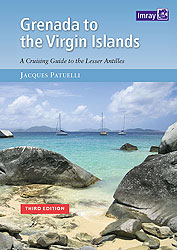
Destinations
Map of Lesser Antilles
Everything about
archipelago
Sailing in the Lesser
Antilles(charts with
routes and wp)
Services directory
(Blue pages)
Order the guide
Mail
Last informations
Warning

Guadeloupe
|
Guadeloupe, nicknamed the Emerald
Isle, is actually two islands separated by
a narrow seawater channel, the Rivière
Salée. The ensemble looks rather like a
butterfly with its wings spread over the
emerald sea under the blue sky. The
prosaic geographical truth is one of great
contrast. Grande Terre (which means Big
Land but in fact is the lower of the two
islands) is a large, rolling limestone
plateau. Basse Terre (meaning Low
Land) is in fact mainly a high, forestcovered,
mountainous and volcanic
massif. The whole is connected by an
excellent and well-maintained road
network, which ensures easy access to
everywhere worth seeing.
|
There’s a huge range of top end hotels
in Guadeloupe, mostly in Grande Terre
and clustered near the beaches at Gosier
and the superb lagoon of St François. On
Basse Terre you’ll find simpler places and
lots of holiday cottages for rent. Around Pointe-à-Pitre, Gosiers and St François restaurants are pretty touristy, though you’ll still find good French and local cuisine at affordable prices. In the less visited areas (Grand Terre’s windward coast, Grand Cul-de-Sac Marin, and Basse Terre’s leeward coast) there are lots of restaurants with local Creole cuisine, in general first class and worth visiting if you make a tour. Pointe à Pitre Pointe-à-Pitre is a sub-prefecture and has a population of about 30,000. However, if you add in the suburbs and satellite townships, that rises to about 100,000 folk who call themselves ‘Pointois’ (pronounced Point-wah). Despite the often stifling heat and the noisy traffic jams, which pollute Pointe-à-Pitre, the old town still has some fine places of interest tucked away, their 19th century colonial architecture well worth a visit. |
|
|||||





